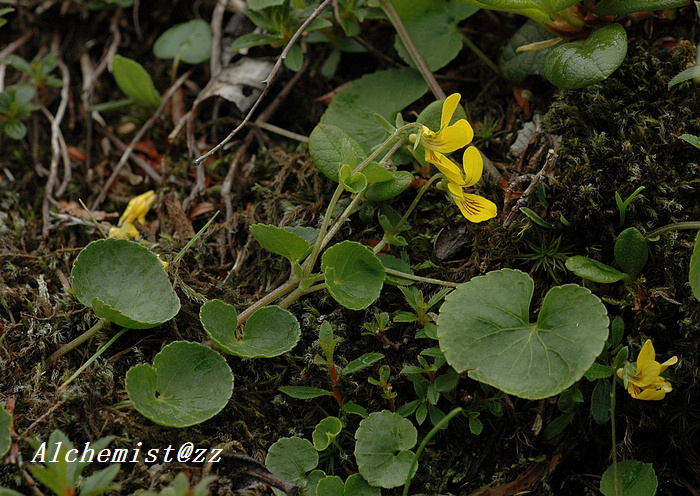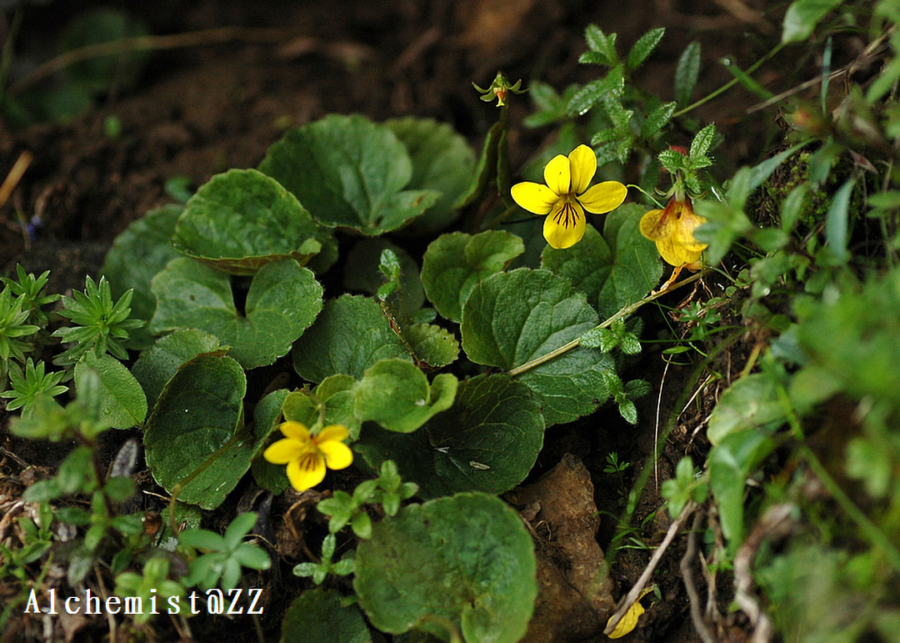双花堇菜 Viola biflora
- Scientific Name: Viola biflora L.
- Ref: Sp. Pl. 2:936. 1753
- English Common Name: twoflower violet, alpine yellow-violet
- Chinese Common Name: 双花堇菜 shuānghuā jǐncài
- Japanese Common Name: キバナノコマノツメ [黄花の駒の爪] kibananokomanotsume
- Family: Violaceae
- Genus: Viola
- Distribution: Alpine or subalpine meadows and grassy slopes, thickets, forests, forest margins, rocks and rock crevices; 2500-4300 m. Gansu, Hebei, Heilongjiang, Henan, Jilin, Liaoning, Nei Mongol, Ningxia, Qinghai, Shaanxi, Shandong, Shanxi, Sichuan, Taiwan, Xinjiang, Xizang, Yunnan [Bhutan, NE India, Indonesia (N Sumatra), Japan, Kashmir, Korea, Malaysia, Mongolia, Myanmar, Nepal, Russia; Europe, North America].
- Photo: 07/14/2009, Mt. Taibai, Qinling
Herbs perennial. Rhizome erect or obliquely ascending, slender or slightly robust, noded, with numerous rootlets. Stems 2 or several fasciculate, erect or obliquely ascending, 10-25 cm tall, slender, 3-5-noded, usually glabrous or sparsely puberulous when young. Basal leaves 2 to several; petiole 4-8 cm; leaf blade reniform, broadly ovate, or suborbicular to orbicular, 1-3 × 1-4.5 cm, abaxially glabrous, adaxially sparsely puberulous, sometimes puberulous on both surfaces, base cordate or subtruncate, margin obtusely dentate or shallowly repand-crenate, apex obtuse. Stipules free, ovate or ovate-lanceolate, 3-6 mm, margin entire or remotely denticulate, apex acute; cauline leaves shortly petiolate; petiole glabrous or puberulous; leaf blade smaller than basal ones. Flowers yellow, sometimes whitish at late anthesis; pedicels 1-6 cm, slender, 2-bracteolate at upper part; bracteoles lanceolate. Sepals linear-lanceolate or lanceolate, 3-4 mm, apex acute, basal auricles very short, margin membranous, glabrous or shortly ciliate in middle and lower parts. Petals oblong-obovate, 6-8 mm, purple veined, lateral ones inside not barbate, anterior one ca. 1 cm (spur included); spur shortly cylindric, 0.5-2.5 mm; spur of anterior stamens shortly triangular. Ovary glabrous; styles clavate, base slightly geniculate, deeply 2-lobed in upper half, lobes obliquely spreading, with a conspicuous stigma hole in between lobes. Capsule oblong-ovoid, 4-7 mm, glabrous. (Flora of China)

07/15/2008, Mt. Changbai, Jilin
